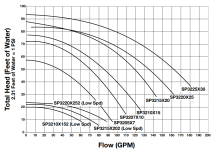If you have the Performance Curve for the Impeller, you can estimate the power required based on the maximum flow and head loss at the maximum flow.
For example, the maximum flow for a SP3215X20 is about 140 GPM and about 30 feet of head loss.
You can even extend the graph to about 150 GPM and about 20 feet of head loss.
You would have to know the efficiency of the pump at that flow and head loss.
The efficiency is usually highest at the center of the Pump Performance Curve and lowest at the ends of the curve, so the efficiency would probably be pretty low.
In any case, Hayward put a 2.2 HP motor on that impeller, so that should be the correct rating for any replacement motor.
The correct label would be 2.2 hp, not 1.5 HP.


Below is a different pump, but you can see that the efficiency at full flow is about 25%


centrifugal pump power |
pump efficiency | 0.25
fluid density | 1000 kg/m^3 (kilograms per cubic meter)
flow rate | 150 gal/min (gallons per minute)
differential head | 20 feet
gravitational acceleration | 1 g (standard acceleration due to gravity on the surface of the earth)
shaft power | 2.263 kW (kilowatts)
= 3.035 hp (mechanical horsepower)
= 2263 W (watts)
P = (q ρ g h)/η | |
P | shaft power
η | pump efficiency
ρ | fluid density
q | flow rate
h | differential head
g | gravitational acceleration

Wolfram|Alpha brings expert-level knowledge and capabilities to the broadest possible range of people—spanning all professions and education levels.

www.wolframalpha.com
The award-winning, energy-efficient IntelliFlo3 VSF Pool Pump has a quiet design with sensorless flow control, app connectivity, and automation capability.

www.pentair.com








